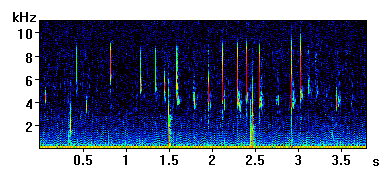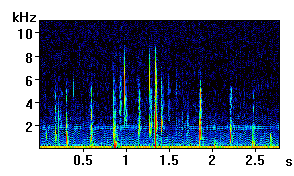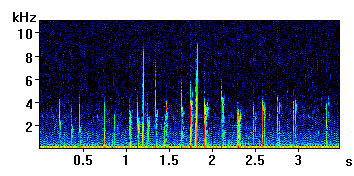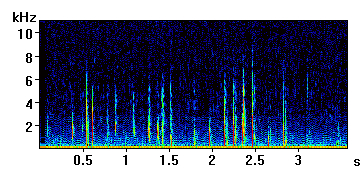Further, there's a list of links taking you directly to other bat sounds on the 'net.
Also, please take a look at my bat call analysis page.
Home-recorded heterodyne detector sounds
These sounds have been recorded with my 'enhanced' TCA440 detector in September 1998 and have been identified as originating from Pipistrellus pipistrellus. In between navigation calls you can hear some broadband social calls, these were also audible to the naked ear. The recordings have all been done at slightly different center frequencies, so they all sound slightly different in pitch, but all recordings were done around 40 kHz.The WAV files are rather big, so I converted them to MP3. A free MP3-player can be downloaded from WinAmp.
The pictures show the spectrogram of the sound clips. The horizontal axis shows the time, the vertical axis shows frequency and the color of the graph shows the signal strength. For example, the broadband social calls can be identified by the vertical lines extending to the horizontal axis. The navigation calls are also (almost) vertical, but do not extend completely to the horizontal axis.
-
bat1.wav (164 kB)
bat1.mp3 (30 kB)

-
bat2.wav (120 kB)
bat2.mp3 (23 kB)

-
bat3.wav (150 kB)
bat3.mp3 (28 kB)

-
bat4.wav (547 kB)
bat4.mp3 (100 kB)

-
bat5.wav (154 kB)
bat5.mp3 (29 kB)

Bat sounds on the internet
- Raimund Specht has a collection
- At the Bat ecology and bio-acoustics Lab at the University of Bristol
- At Cees Bakker's page
- At the page of David J. Bale
- At the Moorhen homepage
- At the page of Frank Pliquett
- At this page of Stag Electronics
- At Von Laar
- Flying foxes in Australia
This page was last updated October 18th, 2006